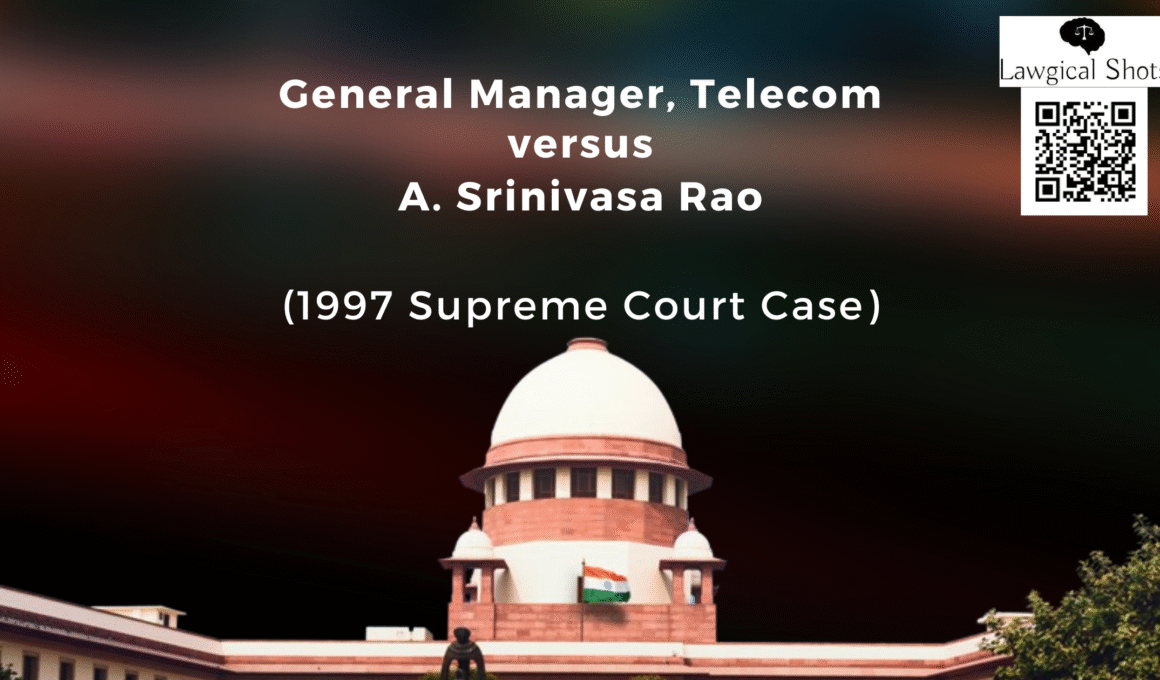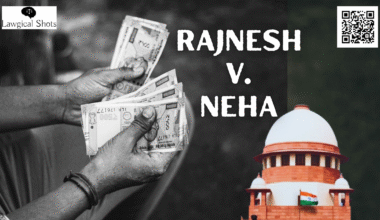The relationship between employers and employees is a big deal in any country, especially when it comes to making sure workers’ rights are protected. In India, a statute called the Industrial Disputes Act, 1947 handles this relationship and assists in settlement of disagreements. A key part of this law is the term “industry[1].” Many of the benefits and protections in the Act only apply to employees working in what the law considers an “industry.” So, figuring out what counts as an “industry” is a huge deal for millions of workers.
This blog looks at a very important case: General Manager, Telecom v. A. Srinivasa Rao (1997)[2]. In this case, the Supreme Court of India had to decide if the government’s telecom department was an “industry” under the law. The answer would determine whether thousands of telecom workers could get the protections and help from the Industrial Disputes Act. The problem started when some telecom employees felt they were treated unfairly and tried to get justice through the Act. The government’s telecom department argued it was not an “industry,” so the law shouldn’t apply to them. This disagreement put a spotlight on how the term “industry” should be understood, especially for government departments.
What made this case so important was the confusion from earlier court decisions. The Supreme Court had sometimes given a narrow definition, saying government organizations that do public service were not industries. But in a more famous case, Bangalore Water Supply and Sewerage Board v. A. Rajappa[3], the court had a broader view, saying almost every business or service, even those run by the government, could be an industry. It made a few exceptions for specific “sovereign functions” like the military, police, or courts.
In the Srinivasa Rao case, the Apex Court looked at both sides carefully. It decided that the telecom department was indeed an “industry” because it provided a commercial service to the public. The work it did was not a core “sovereign” job like making laws or national defence. The judges also pointed out that a new, narrower definition of “industry” that Parliament passed in 1982 was never actually put into effect. This meant the older, broader definition from the Bangalore Water Supply case was still the law.
This decision in General Manager, Telecom v. A. Srinivasa Rao had a major impact on Indian labour law. Not only did it give thousands of telecom workers the right to use the Industrial Disputes Act, but it also set a precedent for other government employees in similar non-sovereign roles. The ruling made it clear that judges have to follow decisions from higher courts, which helps keep the law consistent. By rejecting the narrower view from some recent cases, the court promoted a fairer and more inclusive approach to workers’ rights in India. This blog aims to break down these complex legal issues, explain the court’s reasoning, and show why this judgment is still so important today.
General Manager, Telecom v. A. Srinivasa rao – Case Analysis
Case Citation: General Manager, Telecom v. A. Srinivasa Rao, (1997) 8 SCC 767.
Court: Supreme Court of India.
Bench: A three-judge bench consisting of Chief Justice A.M. Ahmadi, Justice B.N. Kirpal, and Justice V.N. Khare.
Date of Decision: November 18, 1997.
Background of the Case
The Supreme Court case, General Manager, Telecom v. A. Srinivasa Rao, was heard by a three-judge Bench to resolve a conflict in previous rulings. Earlier two-judge benches, in the cases of Sub-Divisional Inspector vs. Theyyam Joseph (1996) [4]. and Bombay Telephone Canteen Employees’ Association V. Union of India (1997)[5], had decided that the Postal and Telephone Departments were not an “industry” because their functions were considered sovereign duties of the state.
However, these rulings contradicted a binding seven-judge Bench decision from 1978 in the Bangalore Water Supply case. That case established the “Dominant nature test”, which states that an organization is an “industry” if its primary activities are commercial or welfare-oriented, with only strictly sovereign functions (like defence) being exempt.
The court in the General Manager, Telecom case noted that the two-judge benches had overlooked this binding precedent. The central question was whether the Telecom Department, despite being a government body, was primarily engaged in commercial activities.
Facts in General Manager Telecom v. Srinivasa Rao
The Worker’s Plea
A. Srinivasa Rao (Respondent) was a casual labourer at the Department of Telecommunications (DoT, Appellant). Despite his “casual” label, he felt he was doing a permanent job. He’d been working there for a long time, performing the same tasks as the regular employees. But because he wasn’t officially a “permanent” employee, he was denied the rights, job security, and benefits that come with that status. In his eyes, this was deeply unfair. He was a workerjust like the others, and he believed he deserved to be treated as such under the Industrial Disputes Act of 1947.
The Department’s Stance
The Department of Telecommunications saw things differently. To them, Rao was just a temporary, casual hire. They argued that because he wasn’t a permanent employee, he couldn’t demand the same benefits or status. They felt he was not entitled to the protections of the Industrial Disputes Act, and that their relationship with him was not the kind that the law was meant to protect.
The Legal Showdown
The case went to the Labour Court, and the court sided with Rao. It ruled that he was, in fact, a workman[6] in the eyes of the law and ordered the DoT to make his position permanent. The DoT took the case all the way to the Supreme Court of India. The Court had to decide a pivotal question: Could a casual labourer be considered a “workman” and thus be entitled to legal protection and the benefits of a permanent employee? The outcome would have significant implications for thousands of casual workers across the country.
Section 2(s) of the Industrial dispute act, 1947
“Workmen” means any person (including an apprentice) employed in any industry to do any manual skilled or unskilled, technical, sales promotion, operational, clerical or supervisory work or any work for the promotion of sales for hire or reward, whether the terms of employment be expressed or implied, and for the purposes of any proceeding under this act in relation to an industrial dispute, includes in connection with, or as a consequence of, that dispute, or whose dismissal, discharge, or retrenchment has led to that dispute, but does not include any such person:—
- who is subject to the Air Force Act, 1950 (45 of 1950), or the Army Act 1950 (46 of 1950), or the Navy Act, 1957 (62 of 1957); or
- Who is employed in the police service or as an Officer or other employee of a person; or
- who is employed mainly in a managerial or administrative capacity; or
- Who being employed in a supervisory capacity, draws wages exceeding one thousand six hundred rupees per mensem or exercises, either by the nature of the duties attached to the office or by reason of the powers vested in him, functions mainly or a managerial nature.
Legal Issue
The central issue was whether the Telecommunication Department could be classified as an “industry” as defined in Section 2(j)[7] of the Industrial Disputes Act, 1947. This was crucial for determining whether disputes involving its employees could be referred to an Industrial Tribunal for adjudication.
The concept of Dominant nature test
The dominant nature test becomes central to the case of General Manager, Telecom v. A. Srinivasa Rao. The government’s telecom department argued it was a government body and therefore not an “industry.” However, the Supreme Court used the dominant nature test, which was already established in the famous Bangalore Water Supply and Sewerage Board v. A. Rajappa case.
The Court reasoned that even though the telecom department was part of the government, its main function was to provide a commercial service (telecommunication) to the public. This service was not a “sovereign function” like national defense or maintaining law and order. By applying this test, the Court concluded that the commercial nature of the telecom department’s work was its most important characteristic. Therefore, it was indeed an “industry” under the law, and its employees deserved the protections of the Industrial Disputes Act. This ruling reinforced the dominant nature test, ensuring that government organizations could not escape their duties to workers simply by claiming to be a part of the state
How It Works?
Imagine an organization that has several departments. Some of these departments might fit the definition of an “industry” (like a factory that manufactures goods), while others might not (like an administrative department that handles government-like work). The dominant nature test helps decide the status of the entire organization.
The test focuses on the following:
- What’s the main function? The court will look at the primary activity of the organization as a whole. Is its core purpose to produce goods, provide a commercial service, or engage in a business-like activity?
- Is the organization integrated? If the different departments are all closely linked and work together to achieve a single main goal, then the organization is seen as one complete unit. The character of the most important part of that unit will decide its overall nature.
For example, a municipal corporation has departments that provide water and electricity (which are commercial services and considered an “industry”) and also departments that handle public health and law and order (which are typically seen as “sovereign functions” and not an “industry”). The dominant nature test would look at which of these activities is the main, overriding purpose of the corporation to determine if the whole body is an “industry” under the law.
Essentially, the test prevents organizations from getting out of their legal duties by claiming that they perform some non-industrial activities. It ensures that if the primary goal of a complex organization is industrial in nature, all its employees—even those in the non-industrial departments—get the protections and rights of the Industrial Disputes Act. It’s a way of looking at the bigger picture to make sure workers aren’t left without legal protection.
Judgment in General Manager, Telecom v. A. Srinivasa Rao
Think of the case General Manager, Telecom v. Srinivasa Rao (1997) as a big legal showdown that had to settle a simple question: “When the government runs a phone company, is it acting like the government or like a business?”
The Supreme Court decided it was acting like a business.
The Court’s decision was based on a rule they had already established years earlier in the Bangalore Water Supply case. This rule, known as the “dominant nature test,” is straightforward: if an organization’s main activity is commercial—providing services for a fee, for example—then it should be considered an “industry” under the law, regardless of who owns it. The Court reasoned that since the Telecommunications Department charged people for its telephone services, it was engaging in commercial activity, not just performing a basic function of the state.
The judgment also served as a firm reminder to other courts. Two smaller court benches had recently ruled that the postal and telecom departments weren’t industries. The Supreme Court effectively said, “Hold on, you can’t just ignore a major precedent set by a larger bench. We have a clear rule, and we’re sticking to it.”
In the end, the 1997 ruling was a big win for employees, as it meant the Telecommunications Department was an “industry” and its workers were entitled to the protections and rights that come with that classification. It clarified that when a government entity starts acting like a business, it needs to be treated like one under the law.
[1] Section 2(j) of the The Industrial Disputes Act, 1947
[2] (1997) 8 SCC 767
[3] (1978) 2 SCC 213
[4] (1996) 8 SCC 489
[5] (1997) 6 SCC 723
[6] Section 2(s) of the Industrial dispute act, 1947
[7] Section 2(j) of the industrial disputes act, 1947- “industry” means any business, trade, undertaking, manufacture or calling of employers and includes any calling, service, employment, handicraft, or industrial occupation or avocation of workmen; Industrial dispute act, 1947
This is a GUEST POST by Mr. Nischal Kumar Bindra a law student at Dr. Bhim Rao Ambedkar National Law University, Sonipat.








